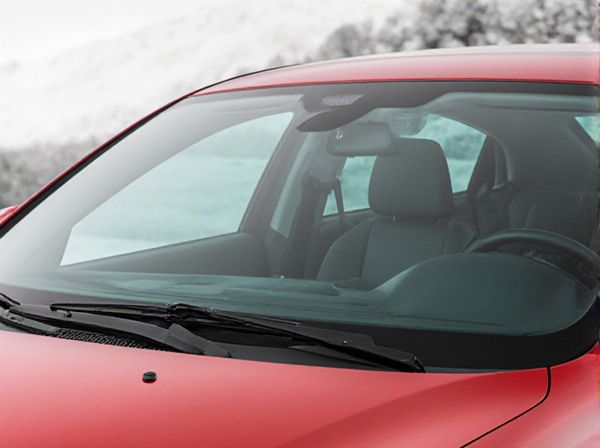
Photo illustration: Clear vs Tinted Windshield
A clear windshield offers maximum visibility and allows more natural light inside your vehicle, enhancing safety during night driving and adverse weather conditions. A tinted windshield reduces glare from the sun and oncoming headlights, helping to keep the interior cooler and protect your eyes from UV rays. Choosing the right option depends on your driving environment and personal comfort preferences to ensure optimal safety and convenience.
Table of Comparison
| Feature | Clear Windshield | Tinted Windshield |
|---|---|---|
| Visibility | Provides maximum clarity and true color perception. | Reduces glare and improves comfort but may slightly affect color accuracy. |
| UV Protection | Offers basic UV protection depending on the glass type. | Blocks up to 99% of UV rays, protecting skin and interior. |
| Heat Reduction | Minimal heat reduction properties. | Significantly reduces heat buildup inside the vehicle. |
| Safety | Standard impact resistance as per regulations. | Enhanced privacy and reduced glare, may affect night-time visibility. |
| Legal Restrictions | Generally legal with no special restrictions. | Subject to local laws; some areas restrict darkness level. |
| Cost | Less expensive with standard manufacturing costs. | Higher cost due to added tinting process and materials. |
Introduction to Windshield Types
Clear windshields offer maximum visibility and are ideal for all weather conditions, ensuring safety by providing an unobstructed view of the road. Tinted windshields reduce glare from sunlight and UV rays, enhancing comfort and protecting the interior from sun damage while maintaining regulatory light transmission levels. Understanding the differences in materials and tint levels helps drivers choose the most suitable windshield type for their vehicle and driving environment.
What is a Clear Windshield?
A clear windshield is a transparent automotive glass designed to provide unobstructed visibility while protecting occupants from wind, debris, and weather conditions. Made from laminated safety glass, it offers high optical clarity with minimal distortion, ensuring driver safety and compliance with vehicle safety standards. Clear windshields typically do not have any tint or shading, allowing maximum light transmission for optimal daytime and nighttime driving visibility.
What is a Tinted Windshield?
A tinted windshield features a subtle layer of film or glass treatment that reduces glare and blocks harmful UV rays while maintaining visibility. This tint helps minimize eye strain for drivers and increases comfort by reducing heat inside the vehicle. Unlike clear windshields, tinted variants enhance privacy and protect the car's interior from sun damage without compromising safety standards.
Key Differences Between Clear and Tinted Windshields
Clear windshields offer maximum visibility and allow the most light to pass through, ensuring optimal driver safety, especially in low-light conditions. Tinted windshields reduce glare from sunlight and UV rays, enhancing comfort and protecting the vehicle's interior from fading, but they may slightly impair visibility under certain conditions. Regulations on the permissible level of tint vary by region, making it essential to choose a windshield coating that complies with legal standards while balancing comfort and safety.
Visibility and Safety Comparison
Clear windshields provide maximum visibility by allowing unobstructed light transmission, which enhances driver awareness and reaction time, especially in low-light or night driving conditions. Tinted windshields reduce glare from sunlight and oncoming headlights, improving comfort and decreasing eye strain, but excessive tinting can compromise visibility and increase the risk of accidents. Regulatory standards often limit tint darkness to balance glare reduction with maintaining sufficient transparency for optimal safety.
UV Protection: Clear vs Tinted
Tinted windshields provide superior UV protection by blocking up to 99% of harmful ultraviolet rays, reducing skin damage and interior fading. Clear windshields typically allow more UV light to pass through, offering minimal protection despite modern UV coatings. Choosing tinted glass enhances safety and comfort by limiting UV exposure and heat buildup inside the vehicle.
Temperature Control Benefits
Clear windshields provide optimal visibility and allow more natural light, which can increase cabin heat during sunny days, potentially raising interior temperatures. Tinted windshields reduce glare and block a significant portion of UV rays, effectively lowering heat buildup and maintaining cooler cabin temperatures. By minimizing solar heat gain, tinted windshields improve temperature control, enhancing overall comfort and reducing the reliance on air conditioning.
Legal Considerations and Regulations
Clear windshields are universally legal and meet standard safety regulations for visibility, whereas tinted windshields face varying restrictions depending on regional laws and permissible Light Transmission Values (LTV). Most jurisdictions set specific limits on the degree of tinting allowed to ensure driver visibility and prevent obstruction of law enforcement inspection views. Failure to comply with local tinting regulations on windshields can result in fines, vehicle inspection failures, and mandatory removal of the tint film.
Cost and Installation Factors
Clear windshields generally cost less than tinted ones due to lower manufacturing expenses and simpler installation processes. Tinted windshields require specialized materials and precise application techniques, increasing both initial cost and labor time. Installation of tinted glass often demands professional expertise to ensure proper fit and UV protection compliance, further impacting overall expenses.
How to Choose the Right Windshield for Your Vehicle
Selecting the right windshield involves considering factors such as climate, driving habits, and vehicle type. Clear windshields provide maximum visibility and are ideal for most weather conditions, while tinted windshields reduce glare and heat, improving comfort in sunny regions. Ensure the chosen windshield complies with local regulations and maintains optimal safety standards for your vehicle.
 caratoz.com
caratoz.com